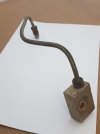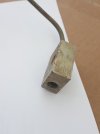BrianM
'74 - Blue Bomber
Team,
I need to change the brake master Cylinder on my '74 X1/9. Dropped the full assembly and while removing the break lines from the system in place, one line twisted off! Unfortunately I believe this is the hard line to the rear brakes. Not nearly enough pipe under the dash to add a new flare. Any ideas?

I need to change the brake master Cylinder on my '74 X1/9. Dropped the full assembly and while removing the break lines from the system in place, one line twisted off! Unfortunately I believe this is the hard line to the rear brakes. Not nearly enough pipe under the dash to add a new flare. Any ideas?
Last edited:



